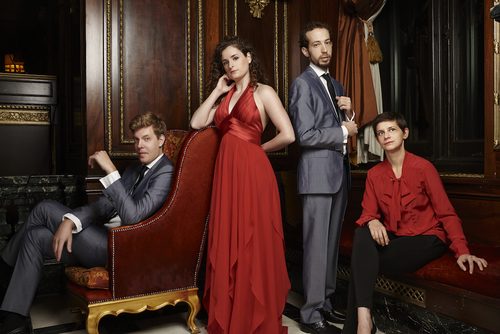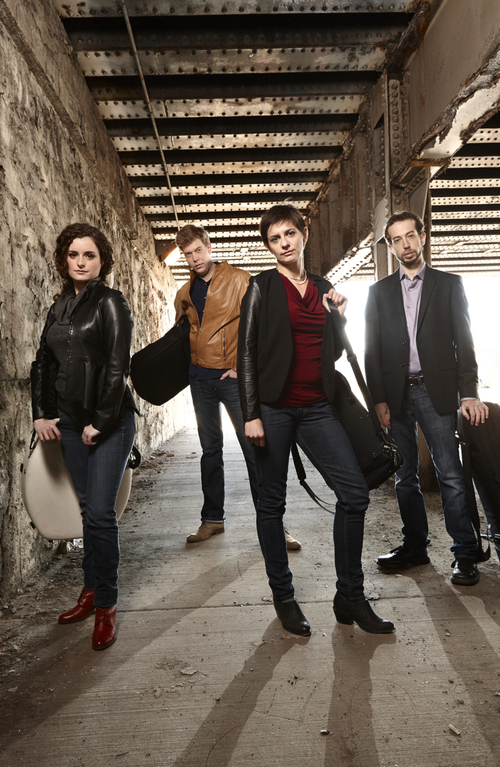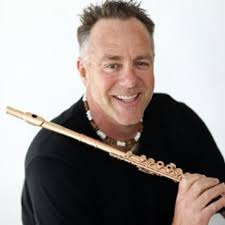Ariel Quartet Performs for UC San Diego’s “ArtPower”

Ariel Quartet (used by permission, Ariel Quartet)
The lithe and taut playing of the Ariel Quartet stands in contrast to their relative youth. Neither is their youth evidenced by their terrific sound and the mostly solid rhythmic control which was on display at their UC San Diego ArtPower concert on Friday, April 21, 2017. The Conrad Prebys Concert Hall with its intimate size and salubrious acoustics was a nearly perfect venue for them.
Opening with Beethoven’s Quartet in A Major, Op. 18, No. 5, the group established that it was on familiar turf. In the ten years since their founding, they have already performed the complete Beethoven String Quartet cycle numerous times in this country, Israel, and Europe. The opening Allegro was marred by some forced bowing, although this was probably due to nervous opening jitters. Settling down in the second movement, the group demonstrated gorgeous flotando bowing that lent the Menuetto and Trio a lovely, charming and elegant air.
As one of the relatively few quartets on the scene to have adopted sharing the first violin chair, Alexandra Kazovsky demonstrated a mastery of her part and lavishing the kind of care and attention to detail that is usually only reserved for the solo parts of major concertos. Throughout the second movement, the other musician clearly could have expended greater effort on phrase endings. Regardless, the entire group played with admirable intonation throughout the whole program. Allowing slightly more time to let phrases breathe would have been an improvement. Instead, there was a sense of cramming too much music into too small of a space.
The third movement, Andante cantabile con variazioni, was a clear victory for the musicians. Their uniform bowing, consistent points of string contact and nicely poetic playing created a clarity and exemplary texture that allowed the delineation of the most important melodic lines.
Cellist Amit Even-Tov’s facial expressions were like a window into the emotions that she and her colleagues were experiencing musically. The gestures were not overwrought but appeared to be sincere and natural and were a delight to witness. Perhaps owing to the players’ intimate knowledge of this quartet and fine musicianship, there were no perceivable holes in their ensemble playing.

Ariel Quartet (used by permission, Ariel Quartet)
My pet peeve with many, if not most classical musicians, is the physical disembodiment of their rhythmic articulation. It is as if the notion of rhythm has been intellectualized instead of being felt corporeally. To wit, there is a story that at the premiere of Gustav Mahler’s Fifth Symphony, the audience was furious with the composer for ending the piece in D Major after beginning in C# minor. What has always seemed astonishing is that the public was able to perceive this minute tonal shift after listening to a highly chromatic, hour-long piece. I cannot imagine a modern audience being as sensitive to pitch and harmony although rhythmically, contemporary society is acutely aware. I have personally experienced dancers on the dance floor throwing objects and hurling curses at the onstage musicians if their time wobbled. I can only wish that contemporary audiences AND musicians would bring a corresponding level of sensitivity to rhythmic issues as the listening public at the premiere of Mahler’s Fifth!
Switching violin chairs for Mohammed Fairouz’s “Prophesies,” Gershon Gerchikov brought an entirely different sound concept to bear than Kozovsky. Although the Fairouz parts were not nearly as flashy as those of the Beethoven, he brought a different kind of virtuosity. The eight-movement work, in only its second hearing in this West Coast premiere, was purportedly “about” the supposedly profound intersections between Judaism and Islam. Three quarters of the Ariel Quartet are Jewish Israelis, and Fairouz is apparently a Muslim. The titles, with names such as “Saleh,” “Dawood,” “Musa,” and “Suleiman” did not lend themselves immediately to any extra-musical associations since their definitions were not available, nor were there any program notes. More familiar titles such as “Yaqub” (Jacob), “Yishak” (Isaac or Yitzakh) and “Ibrahim” (Abraham) were bereft of tangible and plausible associations owing to a lack of information. It seems that Fairouz’s programmatic assertions lacked any program at all. What was the composer’s intent? Why those titles and what is their relationship to the music that we heard? These questions were all left unanswered and as such, there was no extra-musical passageway to guide one into the inside of the work.
Consequently, the music had to stand on its own. It was a pleasant and entertaining enough piece, and the musicians performed it as if it had been written for them (it had). Their patience and discipline created several ravishing sonic moments, disassociated as they may have been from any larger and more meaningful sense of place. Hopefully, more information will be available as time progresses, although it would be surprising if the piece entered anything resembling the standard quartet repertoire. Kudos for having the courage to tackle and present a truly contemporary work in any case and bravo to whomever commissioned it for the Ariel Quartet.
Closing out the program was Robert Schumann’s mammoth String Quartet in A Major, Op. 41, No. 3. The piece’s beginning was like a door magically opening, behind which a string quartet had been playing all along: the sense of being welcomed in was palpable. Gerchikov’s impassioned playing from the first violin chair could nonetheless not avert the impression that this was the quartet’s least familiar and probably most difficult challenge of the evening. They seem to have come to the Schumann long after the Beethoven. To call their effort weak would be hyperbole, but clearly such an enormously difficult piece requires more years of rehearsal and performance before it will feel even marginally comfortable.
Nonetheless, the Quartet gave the work 125% of their effort, and the audience was extremely pleased and receptive to their effort. Schumann’s level of motivic abstraction and tight developmental technique were beautiful to behold.
In studying the group’s resume, it was mentioned that they had spent a year in Basel, Switzerland studying with Walter Levin, the founding first violinist of the famed LaSalle Quartet. That year of study showed: the wondrous Ariel Quartet does indeed seem to be cut from the same bolt of cloth as that predecessor in their sound and phrasing. One can only hope that the musicians are able to get along with one another and begin to approach their predecessor’s durability and longevity. The future seems bright indeed for the Ariel Quartet, and I look forward to watching them grow and develop.

Yochanan Sebastian Winston, Ph.D. has performed throughout the United States, Europe and Latin America. His repertoire spans classical, jazz, klezmer, new age, contemporary, rock & roll and pop and is very active as a composer. Dr. Winston holds a Ph.D. from the UCSD, a Diplôme from the Conservatoire National de Region de Boulogne-Billancourt (France), and a Master’s and Bachelor’s of Music from the Manhattan School of Music in New York City.
